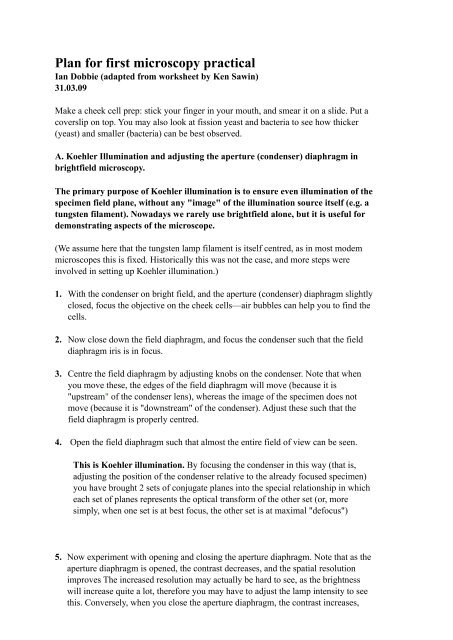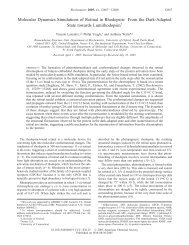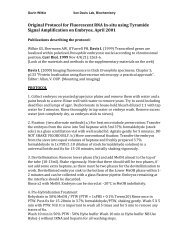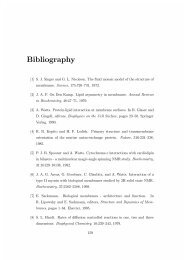Brightfield Worksheet
Brightfield Worksheet
Brightfield Worksheet
Create successful ePaper yourself
Turn your PDF publications into a flip-book with our unique Google optimized e-Paper software.
Plan for first microscopy practical<br />
Ian Dobbie (adapted from worksheet by Ken Sawin)<br />
31.03.09<br />
Make a cheek cell prep: stick your finger in your mouth, and smear it on a slide. Put a<br />
coverslip on top. You may also look at fission yeast and bacteria to see how thicker<br />
(yeast) and smaller (bacteria) can be best observed.<br />
A. Koehler Illumination and adjusting the aperture (condenser) diaphragm in<br />
brightfield microscopy.<br />
The primary purpose of Koehler illumination is to ensure even illumination of the<br />
specimen field plane, without any "image" of the illumination source itself (e.g. a<br />
tungsten filament). Nowadays we rarely use brightfield alone, but it is useful for<br />
demonstrating aspects of the microscope.<br />
(We assume here that the tungsten lamp filament is itself centred, as in most modem<br />
microscopes this is fixed. Historically this was not the case, and more steps were<br />
involved in setting up Koehler illumination.)<br />
1. With the condenser on bright field, and the aperture (condenser) diaphragm slightly<br />
closed, focus the objective on the cheek cells—air bubbles can help you to find the<br />
cells.<br />
2. Now close down the field diaphragm, and focus the condenser such that the field<br />
diaphragm iris is in focus.<br />
3. Centre the field diaphragm by adjusting knobs on the condenser. Note that when<br />
you move these, the edges of the field diaphragm will move (because it is<br />
"upstream" of the condenser lens), whereas the image of the specimen does not<br />
move (because it is "downstream" of the condenser). Adjust these such that the<br />
field diaphragm is properly centred.<br />
4. Open the field diaphragm such that almost the entire field of view can be seen.<br />
This is Koehler illumination. By focusing the condenser in this way (that is,<br />
adjusting the position of the condenser relative to the already focused specimen)<br />
you have brought 2 sets of conjugate planes into the special relationship in which<br />
each set of planes represents the optical transform of the other set (or, more<br />
simply, when one set is at best focus, the other set is at maximal "defocus")<br />
5. Now experiment with opening and closing the aperture diaphragm. Note that as the<br />
aperture diaphragm is opened, the contrast decreases, and the spatial resolution<br />
improves The increased resolution may actually be hard to see, as the brightness<br />
will increase quite a lot, therefore you may have to adjust the lamp intensity to see<br />
this. Conversely, when you close the aperture diaphragm, the contrast increases,
while the spatial resolution decreases. Also note that whereas you could see the<br />
edges of the field diaphragm iris, when you're looking at the specimen you don't see<br />
the edges of the aperture diaphragm as you open and close it. Also, alter the<br />
objective focus above and below the plane of focus, to see how the contrast can<br />
change. Before phase-contrast and DIC were invented, this method was often used<br />
to get a higher contrast image of transparent objects.<br />
6. Return to the properly adjusted Koehler illumination. Now remove one of the<br />
eyepieces and replace it with a phase telescope or insert a Bertrand lens below the<br />
objective if your microscope has one. Either of these will give you a clear view of<br />
the back focal plane of the objective, which is conjugate to the condenser aperture<br />
plane (This can also be done by simply removing the eyepiece but with a phase<br />
telescope/Bertrand lens the back focal plane is magnified and therefore easier to<br />
see). Note that the phase telescope itself can be adjusted for the best focus.<br />
7. Looking down the telescope, adjust the aperture diaphragm—open and close it, and<br />
see that the edges of the iris open and close, and they should be in sharp focus. Do<br />
the same thing with the field diaphragm. Notice that if you change the diameter of<br />
the field diaphragm while looking down the phase telescope, you will not see the<br />
edges of the field diaphragm. Now repeat the same adjustments of the aperture<br />
diaphragm, but look down the eyepiece rather than the phase telescope and observe<br />
the same changes in contrast that you observed before. Hopefully by now you will<br />
have seen and appreciated the notion of conjugate planes and inverse relationship<br />
between the field planes and the aperture planes<br />
B. Phase contrast microscopy<br />
The second purpose of Koehler illumination is that phase-contrast and DIC, the<br />
two major methods generating contrast from "transparent" specimens with<br />
transmitted light, require that the condenser aperture plane is conjugate to a<br />
specific plane in the objective—the "back focal plane" (which is what you were<br />
looking at with the phase telescope/Bertrand lens).<br />
1. Switch the condenser to a phase setting that matches the objective being used,<br />
marked on the objective as Ph-1 or similar. Note that (usually) there is no condenser<br />
aperture diaphragm to open or close, as the aperture diameter is now fixed by the<br />
fixed-size phase-annulus inside the condenser. If possible, take the condenser off of<br />
the microscope and study the different possibilities that can exist in the aperture<br />
plane.<br />
2. Assuming the phase contrast is already well-adjusted - look down the eyepieces at<br />
the cheek cells. Now you will see a great deal of contrast, against a hopefully<br />
uniform grey background. Note that the cell is likely to produce both areas that are<br />
darker than the background and also areas that are lighter than the background,<br />
especially the so-called "phase halo" around particularly thick or refractile objects,<br />
such as yeast. The reasons for the phase halo are quite complex, but it is useful to<br />
know that DIC does not generate such a strong halo (but is much more expensive)
3. You already have had some explanation of how phase-contrast works. To appreciate<br />
it more, take out one eyepiece and insert the phase telescope to look at the back<br />
focal plane of the objective. You should see two rings—a bright ring inside a<br />
somewhat larger dark ring. The bright ring represents the hollow cone light<br />
produced by the phase annulus in the condenser. It is matched in size with the<br />
darker phase ring in the objective. Remember the dark phase ring in the objective<br />
actually does two things. First, it has introduces a phase shift of 90° (one-quarter<br />
wavelength) to the light that passes through it (which is nearly all zero-order, nondiffracted<br />
light). Second, it is also darkened, to reduce the intensity of the zeroorder<br />
light which passes through it. The purpose of this is that only a relatively<br />
small amount of incoming light is actually diffracted by the specimen. Therefore, if<br />
the interference between non-diffracted light and the light diffracted by the<br />
specimen ("higher-order" light) is to be visualised, it is important to reduce the total<br />
intensity of the non-diffracted light. This is also why the background in phase<br />
contrast appears to be grey, even though you may be putting a lot of light onto the<br />
specimen. You will notice if you switch back to the brightfield position on the<br />
condenser, that in phase-contrast, most of the incident illuminating light does not go<br />
into the final image.<br />
4. Now, looking at the back focal plane of the objective, switch to the bright-field<br />
position on the condenser (if you haven't already done so). The ring of bright light<br />
should be replaced by a broader circle. Then switch back to the phase-contrast<br />
position on the condenser.<br />
5. Now see how different adjustments to the system affect the quality of the phasecontrast.<br />
First, with the edges of the field diaphragm in view, reposition the<br />
condenser using its positioning knobs, and see the effect of this, both at the back<br />
focal plane and on the image. Then adjust the position of the phase annulus within a<br />
properly adjusted condenser. (On older microscopes this is easily accessed by the<br />
user and therefore often somebody puts it out of adjustment—on most more modem<br />
microscopes it is more difficult to put it out of alignment. Again observe the<br />
differences both on the back focal plane through the phase telescope and on the<br />
image of the specimen itself, through the eyepiece. You should see that as the bright<br />
ring no longer superimposes on the dark ring, the quality of the phase contrast is<br />
significantly altered.<br />
B*. Darkfield microscopy<br />
If the microscope has a darkfield position in the condenser it can be interesting to see<br />
how this works. If the microscope does not, you can sometimes approximate darkfield<br />
by using the condenser phase annulus for a high-power objective (e.g., Ph 3) in<br />
combination with a low-power low NA objective (e.g. 10X or 20X Ph 1).<br />
1.Look at the cheek cells, and judge whether that's a useful image or not. Compare<br />
how the cells look relative to air bubbles. Try to observe bacteria swimming around<br />
by the cells. Switch back to phase-contrast and see what details are different. Would<br />
dark-field be more suitable for observing the cells? For observing the bacteria?<br />
C. DIC microscopy
The requirements for DIC are polarizer, analyzer, "bottom" Wollaston (in the<br />
condenser) and "top" Wollaston (at the back of the objective). DIC is the most<br />
complicated of all transmitted light methods, and although the principles of DIC are<br />
nearly the same on all microscopes, different manufacturers have engineered the<br />
components differently. Therefore we won't do a lot of playing around with DIC but<br />
rather will just observe the effects of bias retardation, etc. BE EXTREMELY<br />
CAREFUL WHEN MOVING THE OBJECTIVE WOLLASTONS, WHICH ARE<br />
SMALL AND EASILY DAMAGED. IN SPITE OF THEIR SMALL SIZE THEY<br />
COST SEVERAL HUNDRED POUNDS EACH!<br />
1.If possible, take out both Wollaston prisms (shift the turret condenser to bright field<br />
and remove the prism at the objective) so that you have only the polarisers present<br />
(i.e., polariser and analyser). If you have a de Sénarmont-type DIC (rotatable<br />
polarizer), rotate this and observe the effects on the brightness of the image.<br />
Otherwise, or in addition, slide the analyser in and out of position to observe the<br />
effects on the brightness of the image.<br />
2.Now rotate the condenser to the appropriate DIC position to introduce the condenser<br />
Wollaston, and put in the objective Wollaston. Observe the changes in the image.<br />
3.Change the bias retardation ("shadow") by adjusting either the objective Wollaston<br />
(e.g. Zeiss) or the angle of the polarizer if you have de Sénarmont-type DIC (e.g.<br />
Nikon). Notice that as the bias changes from positive to negative (i.e., on either side<br />
of zero, you change the direction of the apparent shadow).<br />
Cleaning components of the microscope<br />
Always keep fresh lens tissue by the microscope. Always. This will encourage people<br />
to use it regularly; this is a lot cheaper than replacing objectives. Lens tissue is very<br />
cheap, and good value for money. Kimwipes, paper towels, toilet paper, must not be<br />
used.<br />
Know the difference between the oil and non-oil objectives on your microscope. If you<br />
are aware of this, and also of the fact that working distances for high NA "dry"<br />
objectives (e.g., 40X/0.9 NA) can be quite short, you are very unlikely to get oil onto a<br />
dry objective.<br />
Wiping the objective: This is especially important on inverted microscopes, since<br />
excess oil can leak down (by gravity) into the objective itself, through the gap used for<br />
the spring-loading. I usually take a piece of fresh lens tissue and fold it over twice, so<br />
that it has 4 layers. Then I wipe the region around the glass very gently, to soak up oil.<br />
The idea of the four layers is that it prevents any oils from your fingers from getting<br />
through. Then I use a fresh piece (folding again) and gently touch the front lens to<br />
remove any oil from there. The main goal is to avoid contacting the lens with the same<br />
region of tissue twice, since the tissue could contain small bits of dust that could<br />
scratch the lens.<br />
Cleaning the objective front lens: The idea is to use a fairly powerful solvent, but to<br />
minimize the time that the lens is exposed to solvent by wicking it away even as it is<br />
applied. The reason is that many solvents can react with the cement that holds the
lenses together, and eventually ruin the objective, so there is a compromise between<br />
using a strong solvent and minimizing its exposure to the lens. If the solvent is highly<br />
volatile, this can help to minimize exposure time. I use chloroform, but you can also<br />
use acetone or isopropanol. Isopropanol is less harsh but might not remove all<br />
contaminants and is less volatile, so will stay on the lens longer.<br />
Take the objective off of the microscope and put it upright on the bench. Examine it<br />
using an inverted eyepiece as a magnifying glass. Alternatively, some people use a<br />
dissection scope. If the objective front lens is covered in media, cells or agar then it<br />
should first be cleaned with water, since the use of solvents will fix the crud onto<br />
the objective, after which you may never get it off.<br />
Assuming that you want to get rid of just oil and dust, have a bottle of acetone nearby.<br />
Take a piece of lens tissue and hold it over the objective from lens. Using a rubber bulb<br />
and a glass pasteur-pipette, drop one or two drops of ether onto the lens tissue above<br />
the front lens. As you are doing this, wick it away by drawing the lens tissue across the<br />
front lens. Look to see if all of the oil is gone. If not, repeat the procedure, with either<br />
fresh lens tissue or a region of tissue that hasn't yet been used.<br />
Cleaning the eyepieces: make a "fresh brush" by licking the ends of lens tissue and<br />
wrapping it around a stick, and licking and sealing the end, and then tearing it off to<br />
make virgin fibres that can be used to touch the glass. One the eyepieces, the major<br />
culprit is usually dust and also a bit of oil from your eyelashes. Quite often this can be<br />
cleaned with just a bit of water. You could squirt a little on the brush, and gently wipe<br />
it around. It is always better to wet the brush lightly rather than squirt a lot of liquid<br />
onto the glass and then try to wipe it all off, since it could seep into unwanted places.<br />
Mascara is very easy to get on and very hard to clean of eyepieces. If you are using a<br />
microscope DO NOT ware mascara.<br />
Do not do this for anything that is coated with something sensitive, such as a<br />
fluorescence interference filter! Antireflection coatings should tolerate water— but<br />
many interference filters will be ruined by water. If you do need to clean them then talk<br />
to the manufacture about how best to clean them. The best solution is not to get<br />
fingerprints on them in the first place.







